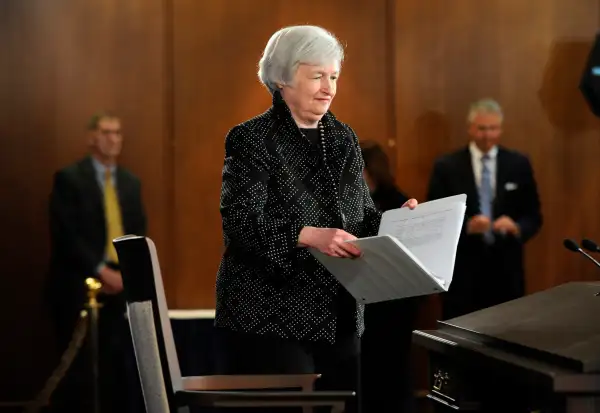Fed: Economy Is Doing Better, But Not Enough to Get Excited (Or Worried) About
Money is not a client of any investment adviser featured on this page. The information provided on this page is for educational purposes only and is not intended as investment advice. Money does not offer advisory services.

Following the meeting of the Federal Reserve's rate-setting body, the news is basically more of the same: Short-term interest rates are staying very low, in the current 0% of .25% range; and the central bank is will continue, as expected, to "taper" the extraordinary program of bond buying that it launched in response to the financial crisis.
In other words, the economy is on the path that Fed chair Janet Yellen and other members of the Federal Open Market Committee want it to be on, but it's far from firing on all cylinders. "Growth in economic activity has rebounded in recent months," said the Fed's published statement. "Labor market indicators generally showed further improvement. The unemployment rate, though lower, remains elevated." Meanwhile, inflation, despite bubbling a bit recently, remains not just tame but in the Fed's view too low. The Fed again: "Inflation has been running below the Committee's longer-run objective, but longer-term inflation expectations have remained stable."
The Fed's read on the economy is important because it shapes the interest rates that businesses, investors, and borrowers can expect in the future. If the Fed sounded really upbeat about growth or more worried about inflation, you'd expect today's historic low interest rates to move up faster. That would be worrying for bond investors, since bonds fall in value as rates rise. At the moment, though, markets seem to be reading the Fed's latest statement as a signal of more of the same. Bond prices rose (and yields fell) slightly in the hour after the Fed's announcement.
One closely watched gauge of the Fed's thinking is the "dot plot", which depicts, in the form of anonymous blue dots, where the various Fed officials think interest rates will go in the future. The higher the dots, the more optimistic the Fed would be about the economy, or the more hawkish on inflation. Here's the latest plot. The dots remain pretty noisy in the near term:
Compared to the last dot plot, expectations for rates in 2016 are a touch higher, but more interesting is that expectations for long-run rates have crept down, suggesting a slightly more pessimistic view about the underlying potential of the U.S. economy. (It's surely a coincidence that the dots also happen to be shaped like a downward pointing arrow.)
In her press conference a few minutes ago, Janet Yellen cautioned readers of the dot plot that "we've had turnover in the committee." So the change in projections may partly be due to different people submitting dots. Yellen conceded, though, that "it's fair to say there's been a slight decline." That's a slightly dovish sign that might be cheering for bond holders. For everyone else hoping to get the damage of the great recession behind us, it may just mean we're in for a longer slog.
